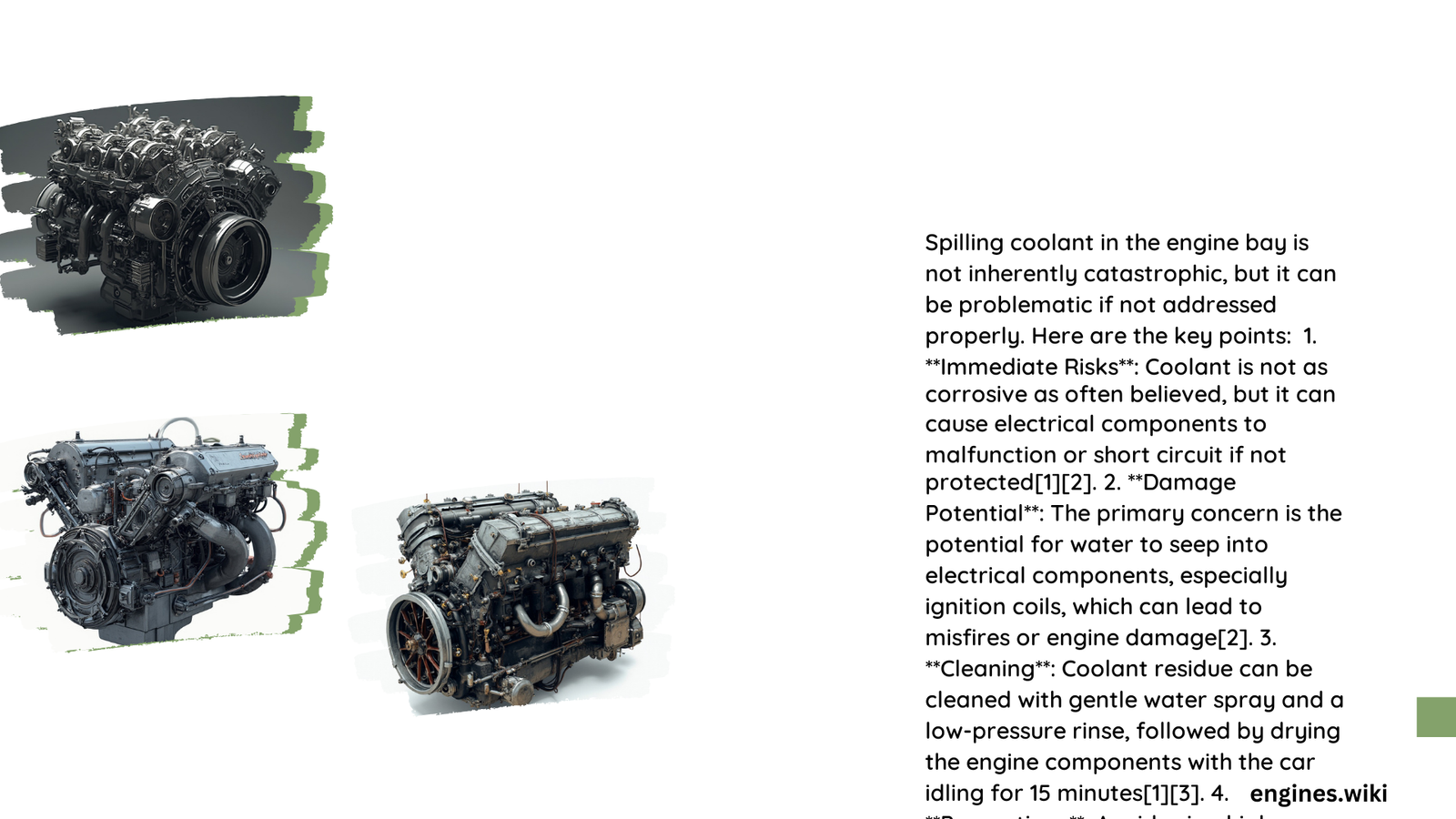Spilling coolant in the engine bay is indeed bad and can lead to serious consequences. Coolant contains corrosive chemicals that can damage various engine components, including belts, pulleys, and electrical systems. The immediate effects can range from component failures to long-term corrosion issues. Proper cleanup is crucial to prevent further damage, and understanding the implications of coolant spills is essential for maintaining your vehicle’s health and performance.
What Are the Immediate Effects of Coolant Spills?
Coolant spills in the engine bay can have several immediate negative effects:
- Component Damage: Coolant can harm parts not designed for contact, such as:
- Serpentine belts
- Pulleys
-
Electrical components
-
Bearing Failure: Coolant can wash away grease in pulley bearings, leading to:
- Premature pulley failure
-
Potential cascade of failures in idler and tensioner pulleys
-
Electrical Issues: If coolant reaches electrical connections, it can cause:
- Short circuits
- Corrosion of connectors
- Intermittent electrical problems
How Does Coolant Affect Engine Components Long-Term?

The long-term effects of coolant spills can be equally detrimental:
- Residue Formation: Dried coolant forms a white residue that:
- Corrodes and degrades parts over time
- Causes belts to crack
-
Leads to pulley failure
-
Aluminum Corrosion: If not properly cleaned, coolant can:
- Continue to corrode aluminum components
- Cause long-term damage to engine parts
-
Potentially lead to component failure
-
Electrical Degradation: Residual coolant can:
- Slowly degrade electrical connections
- Cause intermittent electrical issues
- Lead to more severe electrical problems over time
What Are the Temperature-Related Risks of Coolant Loss?
Coolant loss can lead to severe temperature-related issues:
| Temperature Threshold | Potential Risk |
|---|---|
| Above 220°F | Engine overheating |
| Prolonged exposure to high temps | Head gasket failure |
| Rapid temperature fluctuations | Thermal stress on engine components |
- Overheating: Can occur quickly if coolant levels drop significantly
- Head Gasket Failure: May result from pressure buildup due to coolant loss
- Engine Damage: Prolonged overheating can cause severe engine damage
How Much Do Coolant-Related Repairs Cost?
Repairs related to coolant spills can be costly:
- Pulley and Belt Replacement:
- Cost: Several hundred dollars
-
Depends on the number of affected components
-
Radiator Replacement:
- Average cost: Around $400 or more
-
Varies based on vehicle make and model
-
Head Gasket Repair:
- Cost: Can exceed $1,000
- Labor-intensive repair, often very expensive
What Is the Proper Way to Clean Up a Coolant Spill?
Follow these steps to clean up a coolant spill safely:
- Gather Materials:
- Clean shop towels
- Water-based cleaner (e.g., Simple Green)
- Hose
- Mild degreaser
-
Electrical parts cleaner
-
Protect Electrical Components:
-
Cover with plastic bags or protective materials
-
Clean the Area:
- Spray with water-based cleaner
- Gently hose down, avoiding direct spray on electrical parts
-
Use mild degreaser for stubborn residue
-
Dry the Engine Bay:
- Allow several hours or overnight for complete drying
- Remove protective coverings
- Idle engine for 10-15 minutes to ensure all connections are dry
Safety Precautions:
– Avoid direct water spray on electrical components
– Ensure complete drying before restarting the engine
– Use appropriate protective gear during cleanup
How Does Coolant Loss Affect Engine Temperature Regulation?
Coolant loss significantly impacts engine temperature regulation:
- Critical Coolant Levels:
- Must remain above the minimum mark on the reservoir
-
Low levels can lead to rapid overheating
-
Temperature Rise Rates:
- Engine can exceed 220°F within 45-60 minutes of driving with low coolant
-
Overheating risk increases during high-load conditions or prolonged driving
-
Cooling System Components:
- Radiator fans should activate 5-15 minutes after cold start
-
Malfunctioning fans can contribute to overheating
-
Pressure-Related Issues:
- Head gasket leaks can pressurize the cooling system
- May cause coolant to be pushed out through the radiator cap
In conclusion, spilling coolant in the engine bay is indeed bad and requires immediate attention. The potential for both short-term and long-term damage is significant, ranging from component failures to severe engine damage. Proper cleanup and addressing the root cause of the spill are crucial to maintaining your vehicle’s health and preventing costly repairs.
References:
1. Engine Coolant – A Harmless Leak?
2. Coolant splattered all over under the bonnet
3. Coolant splashed over the engine
